
When it comes to personal injury and motor vehicle accident lawsuits, your attorney has an anticipated goal: to settle the case as quickly, efficiently, and fairly as possible. But what happens when going before a jury is the only viable solution?
When you hire a lawyer, their job is to present convincing evidence and a sound argument about your case. The opposing party – usually the at-fault party’s insurance company – considers whether it’s in their client’s best interest to settle based on that argument. Then, each party works to reach a full and fair settlement. This way, there’s no need for prolonged litigation, and you can focus on healing and moving on with your life.
Yet, no matter how compelling your lawyer’s argument may be, a settlement is not always possible. For example, the policy limit might not appropriately compensate you for your injuries. The opposing party might not budge on its less-than-fair settlement offer. Or the insurance company flat-out denies your claim altogether. In these situations, your personal injury or auto accident lawyer may recommend taking your case to court.
At Lee, Myers & O’Connell, LLP, our Aurora personal injury and auto accident attorneys have a large book of jury trial victories throughout Colorado. We’ve earned a reputation for effective, intelligent representation in the Centennial State’s court system. And when we take a case, we approach it with a trial perspective from the get-go.
If you’re concerned about Colorado’s personal injury litigation process and what is involved, we’re here to explain it all.
How Do Visual Elements Become Persuasive Pieces of Evidence at a Jury Trial?
While expert medical witnesses can explain the finer points of a plaintiff’s injury, such as how long it would take for broken ribs to heal, the jury can often get a better sense of things when they’re presented visually. In fact, today’s jurors demand it.
Captivating the attention of a jury is one of a trial attorney’s most important jobs. What makes this process a delicate one is the fact that jurors’ attention spans have dwindled over the years. Whether we like it or not, we live in a society that is glued to smartphones, YouTube, and TikTok videos. So, the pace of a trial must be expedited to allow for the expectations of the jury to be met.
At the same time, jurors are affected by what has become known in trial circles as the “CSI Effect.” TV shows such as CSI: Crime Scene Investigation, 48 Hours Mystery, and Law & Order portray forensic evidence as not just crucial but a failsafe. As a result, when one side presents little or no forensic evidence at a trial – whether the trial concerns a criminal matter or a motor vehicle accident – a jury could be less willing to believe that side.
The presentation of the trial must be succinct and well-planned. Exhibits are used at trial to reinforce testimony, persuade, educate, describe, and maintain the jurors’ interest in your case. They prove that your case is based on sound scientific and medical principles. When used properly, exhibits can focus on your trial theme and leave an impression that will be remembered in jury deliberations. Exhibits must be focus group-tested to ensure that they explain and illustrate key concepts without being over technical.
When the Colorado personal injury and auto accident attorneys at Lee, Myers & O’Connell, LLP, take a case to trial, we make sure the jurors can see exactly how a horrific accident has changed our client’s life. It’s not enough to simply tell it. So, we will often bring high-tech visual aids, such as computer-based models and animations that replicate the accident and demonstrate how the injury occurred. We’ll also present large poster boards that detail how much money a client will have to pay out year after year in medical bills and home health care because of the accident.
Let’s use some examples from an auto accident case we took to a jury. The first is an accident reconstruction video that shows how the crash happened. Because the crash is presented from more than one angle, the jury sees the impact of the oncoming truck meeting our client’s car.

In the next video we showed, the jurors get to see what the accident did to our client’s spine and how cervical plate surgery needed to be performed.

In the final video, we took a look at the neurological functions in our client’s brain, how these functions became damaged due to the auto accident, and what this damage will mean for the client’s life moving forward.

These visuals provided the jury with as much of a compelling story as witness and expert testimony did. By seeing things from a medical/surgical perspective, the jury was able to correlate the severity of the injury with how our client would live the rest of his life.
How Does a Colorado Personal Injury Lawsuit Proceed?
Common instances that give rise to a personal injury claim or lawsuit include:
- Car accidents
- Truck accidents
- Bicycle accidents
- Pedestrian accidents
- Plane accidents
- Slip-and-fall accidents
- Scuba diving accidents
- Defective products
If your personal injury claim in Colorado proceeds to court, this is the typical procedure you and your lawyer may encounter.
Filing the Lawsuit
Your lawsuit formally begins when you and your attorney file a complaint and a summons. You and your lawyer are known as the plaintiff, and the people you’re filing against are known collectively as the defendant. In the complaint, the basic facts of your case and your demand for compensation are established. The summons informs the defendant of pending legal action against them and sets out the time they have to respond to your complaint. The summons must be legally served on the defendant.
Under Colorado law, you have only two years to file a lawsuit from the auto accident or injury date. If you attempt to sue after that deadline, the court will dismiss your case, and you will lose your right to pursue compensation in civil court.
Discovery
In the next step, discovery, the parties involved in your litigation will request information relevant to the claim. They normally include such information as:
- Identities of any expert witnesses who will be called in the case
- Names of eyewitnesses to the accident who will be contacted in the case
- Explanation of how the accident occurred
- Identification of other parties who could share responsibility in the case
- Lists of evidence that will be used in the case, such as police reports, footage from dashcams or surveillance cameras, or eyewitness smartphone video
- Information about the medical treatment you received and are still receiving, wages you lost, and other claimed losses
Once discovery is completed, a trial date may be set.
Motions Filed
After both sides complete discovery, the attorneys will file pretrial motions. These are formal requests before the trial begins asking the judge to decide on your case for a particular legal reason. Among the motions are:
- Motion for Summary Disposition – This asks the court to decide the case immediately. The party who files this motion has reason to believe that the law is on their side and that the court need not probe deeper into the facts of the case.
- Motion for Default Judgment – If the opposing party doesn’t file a formal response to your initial complaint, your lawyer can file a motion for default judgment. If granted, the court will rule in your favor, and you may begin the collection process.
- Motion to Dismiss – The opposing side could always ask the court to dismiss the lawsuit based on several different legal grounds. They could claim improper jurisdiction, lack of notice for the case, or the complaint not stating specifically how you’ve been wronged in a way that would hold the defendant liable.
- Motion Regarding Discovery – Your attorney may object to what evidence you must produce, and the opposing party could object to the evidence they must deliver. A motion regarding discovery (also known as a motion to compel, a motion for a protective order, or a motion to quash) asks the court to step in to resolve the disagreement.
- Motion to Limit Evidence – This motion asks the court to admit or exclude specific evidence before the trial. Because there are rules that govern what evidence the jury can consider at trial, your lawyer or the opposing party’s lawyer could claim that a certain piece of evidence falls outside those rules.
The Trial
If your personal injury claim proceeds to trial in a Colorado court, the process consists of the following events:
Jury Selection
Also called voir dire, this is when the attorneys question potential jurors to determine whether they can be impartial or beneficial to the case. The lawyers then decide on a panel of 12 jurors and 2 alternates to hear and decide the case.
Opening Statements
Your counsel will give an opening statement to the jury, briefly explaining the case and how the injury or wrongful death occurred. The defense attorney will then provide an opening statement that chronicles things from the defendant’s perspective.
Arguments and Witnesses
Your lawyer will call witnesses, experts, and you to the stand to ask questions about the case and establish credibility in the jury’s eyes. Your attorney also presents evidence that supports your case. The defense then cross-examines your witnesses to make their case. Afterward, the defense calls its own witnesses and experts to the stand, allowing your lawyer to cross-examine them.
Closing Arguments
Once you and all the witnesses and experts have presented testimony, the plaintiff and defense address the jury again with a closing argument. The lawyers will summarize their position, point to specific moments of testimony or evidence, and ask the jury to rule in their favor.
Deliberation and Verdict
The jury will then meet in private to discuss the case until they reach a decision. The jurors will reconvene in the court and announce whether you are owed for your injuries and how much the award should be.
Appeals
If one side believes that the other side or the judge made legal errors or violations during the trial, they may file for leave of appeal. The state appellate court will then determine whether the verdict should stand or be overturned or if the errors require a new trial.
How Long Does a Colorado Personal Injury Lawsuit Process Take?
The length of a personal accident lawsuit varies from case to case. One lawsuit could get resolved in a few months with a settlement, while another could take a few years because of tie-ups in the court system.
Among the factors that could affect how long the lawsuit process will take are:
- The court and location where the case is to be heard
- How many other pending cases are ahead of yours
- Whether the parties are responding and complying with requests for discovery
- The complexity of your case’s legal issues
- Whether the case can be resolved through mediation, in which both sides use a neutral third-party mediator to try to resolve the case
- Whether either side is appealing the jury verdict or the judge’s ruling
Can My Colorado Personal Injury Lawsuit Settle During Trial?
While many personal injury cases settle before a complaint is ever filed, there are instances when the parties will resolve claims during litigation. This includes during a jury trial.
The defense side could believe that the plaintiff’s evidence and witness testimony presented before the jury are too damaging for their case. So instead of leaving things in the jury’s hands, the defense may make a settlement offer. If the plaintiff agrees to it, the judge can allow for the case to end.
In a personal injury claim settlement process, a common condition is the plaintiff agreeing to dismiss the lawsuit and release all legal claims against the defendant.
How Much Money Can I Get from a Colorado Personal Injury Settlement?
Because every personal injury or auto accident claim is different, there is no specific amount of compensation associated with a lawsuit. The compensation you could receive is directly related to the value of your damages. These include:
- Current, past, and future costs of medical care, plus long-term care such as home health services
- Lost wages or income, if you missed or are missing work during your recovery period
- Loss of earning capacity and job benefits, if you can’t be gainfully employed due to partial or permanent disability
- Physical pain, anguish, and emotional distress
- Loss of enjoyment or quality of life because of scarring, disfigurement, or reduced life expectancy
What Does Hiring a Colorado Personal Injury and Auto Accident Lawyer Cost?
Personal injury cases are normally handled on a contingency-fee-basis. This means you will not pay anything until the case is successfully resolved on your behalf.
Contact Our Colorado Personal Injury and Auto Accident Law Firm
At Lee, Myers & O’Connell, LLP, we know how to litigate a personal injury case – and we have the results to prove it. Contact us today to speak with an Aurora personal injury attorney about the details of your case. Your consultation is free, and there are no fees for us to begin work on your case.




















